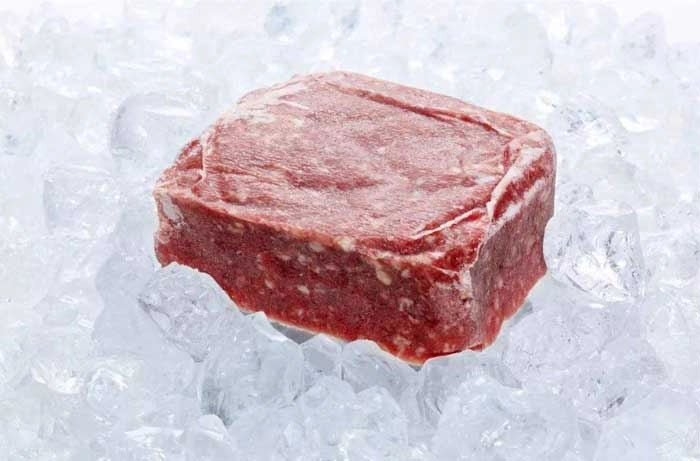| There are a number of myths and misinformation surrounding meat handling, freezing, and defrosting. As you know, we deal with meat every day and are somewhat experts in this area. Meat purchased in the supermarket ‘Fresh’ Aisle is stocked with meat that has mostly been frozen and thawed several times along the supply chain until it arrives in the supermarket where it’s sold in the thawed form. Yet, if you buy meat from the grocery store you have no problem believing this is both fresh and safe, not realizing they have purchased meat that’s frozen and thawed several times over. Freezing meat (properly) does not change the taste. Over a long period of time the taste can be affected, but for 6mos or so, the taste remains unchanged. This is especially true of high quality meats — the higher the quality the more taste/flavor is retained. According to the USDA, “The freezing process itself does not destroy nutrients. In meat and poultry products, there is little change in nutrient value during freezer storage.” Frozen foods will actually retain their nutritional value and can sometimes be higher in vitamins, like frozen fruits and vegetables compared to the fresh stuff in the produce aisle. Why? Frozen fruits and vegetables are usually picked at their peak ripeness, locking in all those vitamins and nutrients when frozen. You CAN freeze and refreeze thawed meat. This is probably one of the most common misconceptions. Experts agree that if the foods were thawed in the refrigerator and kept cold (40 degrees or below), it is safe for refreezing. The U.S. Dept. of Agriculture (USDA) advises: “Once food is thawed in the refrigerator, it is safe to refreeze it without cooking. Do not refreeze any foods left outside the refrigerator longer than 2 hours; 1 hour in temperatures above 90 °F. If you purchase previously frozen meat, poultry or fish at a retail store, you can refreeze if it has been handled properly”, according to USDA. Partially thawed meat is by definition also partially frozen and therefore still extremely cold and well below 40 degrees. Nowhere near any temperature danger zone. Partially thawed, partially frozen meat has a core temperature much colder and safer than that of your home refrigerator. It is still at a temperature much colder and safer than meat sold in the “fresh” meat aisle at a supermarket and is still far too cold for any food-borne pathogens to become active. If your partially thawed, partially frozen meat is also in a package, eg vacuum sealed, this is even better as there is no danger of any contamination or freezer burn due to the vacuum packaging.Think about where you store your Fetching Foods in the freezer. Not everywhere in your freezer is ideal for frozen foods. Consider the freezer door for instance. As much as you open and close it, the temperature there fluctuates more than other areas of your freezer. For long-term freezing of meat, try storing it towards the back or bottom of the freezer (but don’t forget it’s there!). The best way to thaw meat is in the refrigerator. The reason is it’s the safest, but it takes longer. The worst way is to place the meat on the counter to thaw. Two other acceptable ways are to thaw in cold water, like what’s recommended in our article on How To Feed Fetching Foods, or in the microwave. The microwave is difficult since it’s easy to cook the meat during the thawing process. Most people would think nothing of buying fresh meat at the supermarket, place it in the back of a hot car, especially in the summer, and then run some errands for an hour before placing the meat in the fridge at home. This is not considered safe handling, yet done all the time. When meat has been compromised and is in a state of spoilage you’ll notice the packaging swell or inflate, the meat becomes soggy and mushy or soupy, and there is a strong, unmistakable smell of rotting meat. It is VERY obvious when the food is spoiled. High-quality meats like ours tend to be more ‘durable’ since they’re produced under better, more sanitary conditions. And our food is packed in vacuum sealed packaging (better than the typical grocery store packaging, plastic wrap over a styrofoam tray). That doesn’t mean you can ignore basic food safety, but know that you have more grace when handling. Since Fetching Foods is only made with exceptional quality meats and ingredients, not scraps and cast offs from human meat production (eg meats where the food safety protocols were breeched and then needed to be discarded), you can be assured they will remain delicious after months of freezing and safe for feeding. |


In recent years, pet owners have become increasingly concerned about the quality and nutritional value of the food they feed their furry companions. One trend that has been gaining popularity is the use of hydrolyzed ...
Introduction As pet owners, we are constantly seeking ways to improve the health and well-being of our beloved furry companions. One aspect that has gained significant attention in recent years is the use of herbal ...
As we move through this holiday season and towards the new year, we’ve been stuffing our faces as we prepare to stuff our stockings! You might already be at the point where you are loosening ...